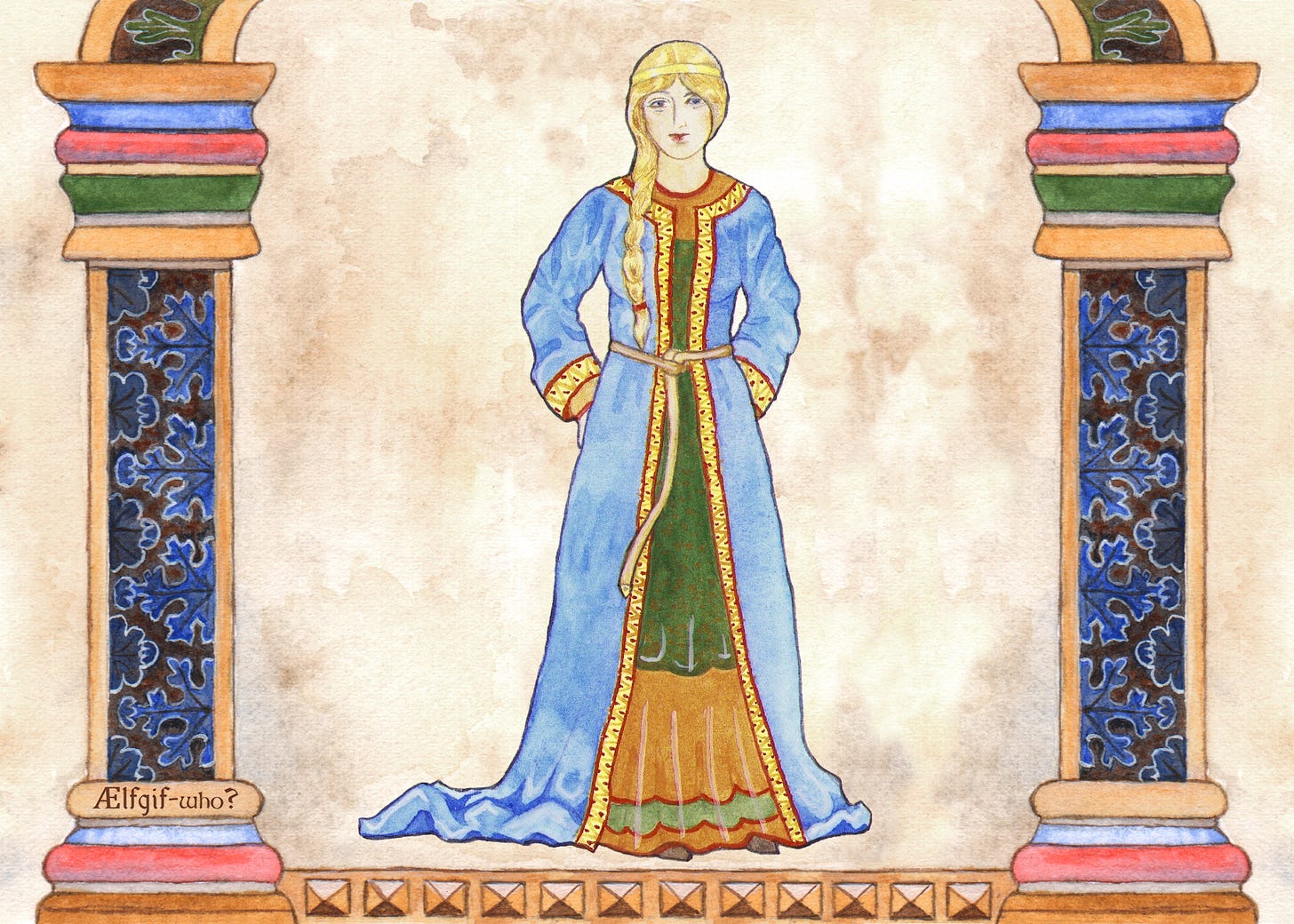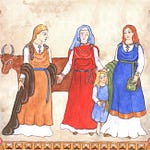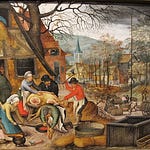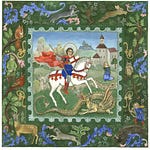Ælfgif-who? provides short biographies of early medieval English women. Good news! You can read my PhD thesis for free here. Click on the podcast player if you’d like to hear this newsletter read aloud in my appealing Yorkshire accent.

Gunhild: A Victim of Medieval Ethnic Cleansing?
Exploring the 1002 St Brice's Day Massacre of the Danes
On this day in 1002 King Æthelred ordered a massacre of all the Danes in England. This massacre, which took place on 13 November, known as St Brice’s Day, was just one instance of tensions between the Danes and the English that spilled over into violence. Vikings from Denmark had been ravaging England since the eighth century, and had recently set up camp in Normandy, a convenient base for raiding the English coast. The St Brice’s Day massacre was by no means the end to the Viking threat in England, in fact this may have been exacerbated by it. It is understood by some as a precipitating factor in the eventual conquest of England by the Danish kings Swein and Cnut that occurred in 1013-1016 - and connecting these two events is the memory of a brave and beautiful woman named Gunhild.
You may have heard of the conquest of England that took place in 1066, when William the Conqueror defeated Harold Godwinson at the Battle of Hastings. But fewer are familiar with the earlier conquest that took place in 1013, when the Danish king Swein and his son Cnut invaded England and subjected it to their rule. The result of this invasion was that their Danish royal dynasty ruled England from 1016 until 1042.
The twelfth-century chronicler William of Malmesbury describes the conquest of England by the Danish king Swein as motivated by revenge. According to Malmesbury, Swein’s sister Gunhild had been brutally murdered in England along with other Danes, including her husband and son:
This woman, who possessed considerable beauty, had come over to England with her husband Pallig, a powerful nobleman, and by embracing Christianity, had made herself a pledge of the Danish peace. In his ill-fated fury, Edric [the earl of Mercia] had commanded her, though proclaiming that shedding her blood would bring great evil on the whole kingdom, to be beheaded with the other Danes. She bore her death with fortitude; and she neither turned pale at the moment, nor, when dead, and her blood exhausted, did she lose her beauty; her husband was murdered before her face, and her son, a youth of amiable disposition, was transfixed with four spears.1
Though he does not say so directly, the means of Gunhild’s gruesome death as outlined by Malmesbury resonate with what we understand happened during the St Brice’s Day Massacre in 1002.
According to the Anglo-Saxon Chronicles, it was on this day that ‘the king ordered all the Danish men who were in England to be slain’. This was in response to repeated Viking raids in southern England. The true extent of the fatalities in King Æthelred’s attempt to eradicate the Danish is unknown, and has been much debated by historians. Some historians refer to the St Brice’s Day Massacre in terms of ethnic cleansing and genocide, while others portray it as an action taken only against violent Viking raiders who had recently settled in England.
A detailed account of the local impact of this massacre is corroborated in a 1004 charter from the church of St Frideswide, Oxford. The charter is written in first person as the king himself, and outlines the violence of the massacre, though Æthelred is more concerned with the damage done to the church itself:
For it is well known to all who dwell in this country, that I set out a decree, with the advice of my nobles and magnates, that all the Danes who had emerged in this island, sprouting like weeds among the wheat, should be killed by a most just judgement […] Those Danes who dwelt in the aforementioned town [Oxford], trying to escape death, broke through the doors and bolts and entered this temple of Christ, and resolved to make asylum there, and a defence for themselves against the people of the town and suburbs; but when all the people who were in pursuit of them were forced by necessity to drive them out and did not succeed, they set fire to the boards and burnt this church, as can be seen, along with its ornaments and its books. Afterwards I renovated it with God's help.2
An archaeological excavation at St John’s College Oxford in 2008 may reveal more about these grisly events. Thirty-seven skeletons dating to between 960 and 1020 were unearthed from a mass grave, mostly comprising of tall, strong young men aged 16-25. The injuries to the skeletons reveal a violent attack on all sides. One had been decapitated, while, perhaps more horrifyingly, several had suffered attempted decapitation. Osteoarchaeologist Ceri Falys concluded that these injuries were inflicted on the men as they were running away, undefended. Some of the skeletons even showed evidence of charring by fire.
This is the gruesome archaeological legacy of the scapegoating of an immigrant group, and the extension of responsibility for specific crimes to everyone who shares the identity of the criminals – political phenomena that are unfortunately not particular to the eleventh century. The St Brice’s Day Massacre serves as a pertinent reminder that persecution on ethnic lines has a long history, but can shift and change according to differing political circumstances.
That this massacre comprised of horrific acts of violence that took place around the country on the same day, by order of the king, seems evident. But were Gunhild and her family among the unfortunate victims of this massacre in 1002?
Some historians have doubted Malmesbury’s testimony about Gunhild. It is only he, writing over a century after the fact, who claims that Swein even had a sister called Gunhild - nor do any other sources corroborate her death or that of her apparent husband Pallig. More confusing is Malmesbury’s mention of Edric as the man who ordered them to be put to death. This does not place her murder on St Brice’s Day in 1002, given that Edric was made Earl of Mercia several years after this.
It has been suggested that Malmesbury had his timeline mixed up, and is conflating the 1013 conquest with raids of England that Swein participated in a decade earlier, soon after the massacre. In his edition of Malmesbury’s chronicle, historian J. A. Giles commented that:
Malmesbury seems to have fallen into some confusion here. The murder of the Danes took place on St. Brice’s day, A.D. 1002, and accordingly we find Sweyn infesting England in 1003 and the following year: but this his second arrival took place, A.D. 1013: so that the avenging of the murder of his sister Gunhilda could hardly be the object of his present attack.3
I don’t know if J. A. Giles had any siblings, but I feel it’s reasonable that Swein would still be angry about the murder of his sister and her family eleven years later. And surely a full-scale conquest would require lengthy planning and preparation. But point taken: Malmesbury’s chronology is certainly confusing.
The main reason to dismiss Malmesbury’s testimony about Gunhild is that the events add up without the added dramatic flair of a brave and beautiful murdered sister. Monetary and political gain are reasons enough to explain Swein’s actions in conquering England, not least the mounting violence between Swein’s countrymen and the English. Thus, some political historians have doubted the existence of Gunhild as a later invention.
With no sources available to contradict the existence of Gunhild or her violent murder, we might keep an open mind. Malmesbury’s narrative, whether confused or truthful, is ultimately enlightening because it forces us to reckon with the fact that this massacre, though distant in time, involved real people. The idea that such a massive historical event might have hinged on a woman, on a bond between siblings, on personal revenge, perhaps feels unsatisfactory to those of us trained to look for political explanations over personal ones. But in ascribing names and characteristics to some of the victims, and showing them as defiant in the face of persecution, Malmesbury humanises the victims of historical violence.












Share this post